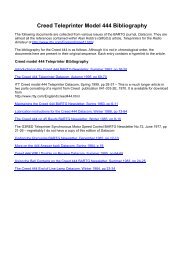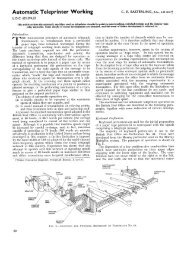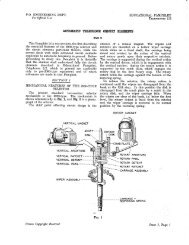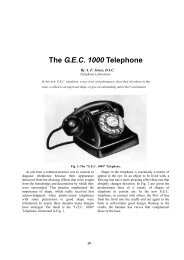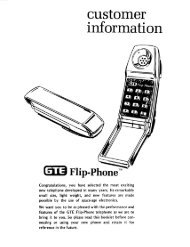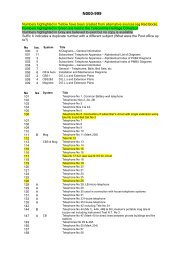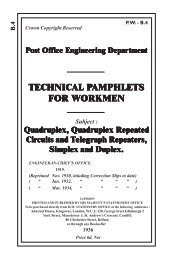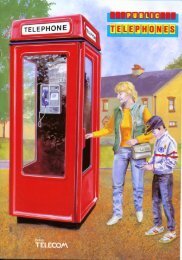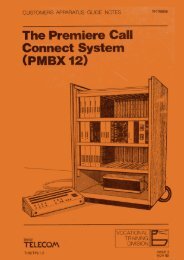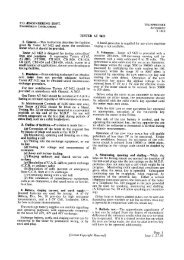TRAFFIC CONTROL TELEPHONE SYSTEMS Circuit - Sam Hallas
TRAFFIC CONTROL TELEPHONE SYSTEMS Circuit - Sam Hallas
TRAFFIC CONTROL TELEPHONE SYSTEMS Circuit - Sam Hallas
You also want an ePaper? Increase the reach of your titles
YUMPU automatically turns print PDFs into web optimized ePapers that Google loves.
Page 42<br />
SA wiper 2, the circuit for relay DC, through its 1,000 ohm winding, is broken when<br />
this switch steps one step from its normal (home) position, and during subsequent<br />
impulses Relay DC is held over its 3 ohm winding in series with IR1 contact and line<br />
switch SA operating coil. Being slow to release, Relay DC does not release during<br />
impulsing.<br />
Line switch SA will take one step for each dial impulse, which, in the case of<br />
code 53, will be five steps, leaving line switch wipers SA3 and 4 connected to line<br />
switch SA bank contacts 6 and line switch SC bank contacts 12 and 10 respectively.<br />
After the tens impulses are completed there will be a pause, whilst the controller reoperates<br />
the dial to send the three (unit) impulses.<br />
During this inter-digital pause, Relay IR will remain operated and Relay DC<br />
releases after a short interval. This causes the digit switching Relay DS to operate via<br />
50 volt negative, Relay DS winding e-a DCl, line switch wiper SA2, G2, GC3, TS2,<br />
to 50 volt positive.<br />
Relay DS locks up via DS1, leaving it independent of DC1 and line switch SA2.<br />
Contact DS3 changing over causes Relay DC to re-operate via 50 volt negative, Relay<br />
DC winding e-d DS3, line switch wiper SB2, G2, GC3, TS2, to 50 volt positive.<br />
Relay G remains operated via IR1, Relay G winding, DC2, Relay DC 3 ohm winding<br />
with resistor YA 50 ohm in parallel, DS2, line switch SB operating coil to 50 volt<br />
negative.<br />
The Controller now dials the three (unit) impulses and Relay IR releases with<br />
the first impulse (break of dial) and line switch SB operating coil will be energised via<br />
50 volt negative, SB coil, DS2, Relay DC 3 ohm winding b-a with resistor YA 50 ohm<br />
in parallel, DC2, IRI, G3, to 50 volt positive. Note. — The operation of IR1 momentarily<br />
short circuits Relay G, but this short circuit makes it slow releasing and it<br />
remains operated during impulsing. Relay IR is again operated when the dial remakes<br />
the impulsing contact after the first impulse, this removes the short circuit from<br />
Relay G at IR1, and connects the winding of Relay G in series with line switch SB<br />
operating coil, which releases and steps the line switch wiper arms. At line switch<br />
wiper SB2, the circuit for Relay DC is broken when this line switch steps one step<br />
from its normal (home) position, and during subsequent impulses Relay DC is held<br />
over its 3 ohm winding in series with IR1 contact and line switch SB operating coil.<br />
Being slow to release, Relay DC does not release during impulsing.<br />
Line switch SB will take one step for each dial impulse (three in this case),<br />
leaving line switch SB 3 and 4 wipers connected to line switch SB bank contacts 4 and<br />
line switch SC bank contacts 23 and 25 respectively. When the dial has returned to



